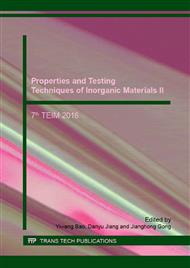[1]
H. Fabian, J. Roeper, U.S. Patent 8, 973, 407. (2015).
Google Scholar
[2]
A. Schuster, R. Sowa, M. Trommer and U. Peper, U.S. Patent 8, 783, 069. (2014).
Google Scholar
[3]
R.D. Groh, B.L. Harper, J.E. Maxon, U.S. Patent 8, 230, 701. (2012).
Google Scholar
[4]
S.R. Burdette, J.G. Fagan, D.R. Sempolinski and P. McLaren, U.S. Patent 8, 110, 277. (2012).
Google Scholar
[5]
L.A. Moore, C.M. Smith, U.S. Patent 7, 964, 522. (2011).
Google Scholar
[6]
B.L. Harper, K.E. Hrdina, J.E. LaSala, U.S. Patent 7, 994, 083. (2011).
Google Scholar
[7]
M. Yoshida, U.S. Patent 8, 919, 152. (2014).
Google Scholar
[8]
M. Yoshida, U.S. Patent 8, 656, 743. (2014).
Google Scholar
[9]
H. Otsuka, K. Shirota, O. Sekizawa, U.S. Patent 8, 596, 095. (2013).
Google Scholar
[10]
J.S. Santos, E. Ono, C.K. Suzuki. Effect of the Nanostructure Control on the Novel Optical Properties of Silica Photonic Glass Synthesized by VAD Method, Mater. Sci. Forum. 636-637 (2010) 361-368.
DOI: 10.4028/www.scientific.net/msf.636-637.361
Google Scholar
[11]
J.S. Santos, E. Ono, E. Fujiwara, T.P. Manfrim and C.K. Suzuki, Control of optical properties of silica glass synthesized by VAD method for photonic components, Opt. Mater. 33(12) (2011) 1879-1883.
DOI: 10.1016/j.optmat.2011.03.007
Google Scholar
[12]
E.F. Vansant, P.V.D. Voort, K.C. Vrancken, Characterization and Chemical Modification of the Silica Surface, Elsevier Science Publishers, New York, (1995).
Google Scholar
[13]
I. A. Rahman, P. Vejayakumaran, C. S. Sipaut, J. Ismail and C. K. Chee, Effect of the drying techniques on the morphology of silica nanoparticles synthesized via sol-gel process, Ceram. Int. 34(8) (2008) 2059-(2066).
DOI: 10.1016/j.ceramint.2007.08.014
Google Scholar
[14]
F. Rouquerol, J. Rouquerol, K. Sing, Adsorption by Powders and Porous Solids: Principles, Methodology and Applications, Second Edition, Academic Press, San Diego, (2013).
DOI: 10.1016/b978-012598920-6/50004-x
Google Scholar
[15]
Pore size distribution and porosity of solid materials by mercury porosimetry and gas adsorption - Part 1: Mercury porosimetry, ISO 15901-1. (2005).
DOI: 10.3403/30106204
Google Scholar
[16]
Pore size distribution and porosity of solid materials by mercury porosimetry and gas adsorption - Part 2: Analysis of mesopores and macropores by gas adsorption, ISO 15901-2. (2006).
DOI: 10.3403/30116588
Google Scholar
[17]
Pore size distribution and porosity of solid materials by mercury porosimetry and gas adsorption - Part 3: Analysis of micropores by gas adsorption, ISO 15901-3. (2007).
DOI: 10.3403/30132411
Google Scholar
[18]
Determination of the specific surface area of solids by gas adsorption using the BET method, ISO 9277. (1995).
Google Scholar


